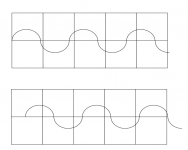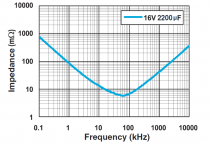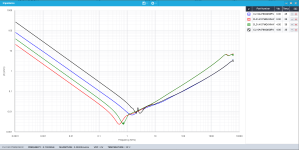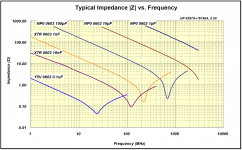Why not?
//
Because 44.1k just doesn't have the (temporal) resolution to accurately represent a 5uS shift. We only get 44.100 samples per second. That means that each sample is taken every ~22uS.
How could we be able to distinguish between a sample taken at 22uS and at 22us+5uS?
It would be like expecting 44.1K to accurately reproduce frequencies way above 22KHz.
I'm afraid this means that you dont understand the sampling theorem and the inner workings of PCM audio. Better read up. But stop spreading that until you are sure.
//
//
Because 44.1k just doesn't have the (temporal) resolution to accurately represent a 5uS shift. We only get 44.100 samples per second. That means that each sample is taken every ~22uS.
How could we be able to distinguish between a sample taken at 22uS and at 22us+5uS?
It would be like expecting 44.1K to accurately reproduce frequencies way above 22KHz.
We have many tools at our disposal, for example dithering
TNT, clearly talk of reference is only meaningful in the audiophilic sense, not that I think the concept matters much to me. So let’s not call a turd reference.
Last edited:
I'm afraid this means that you dont understand the sampling theorem and the inner workings of PCM audio. Better read up. But stop spreading that until you are sure.
//
I saw that one coming. 🙂
So, what would you say would be an acceptable lowest limit of sampling rate to still be able to make out temporal differences of 5uS? 32KHz? 22KHz? 16KHz?
Using real-world reconstruction filters, of course.. Not theoretical perfect ones. 😉
You are also guessing - OK.
//
Would be better if you quote. Dithering will clearly help in this case
We have many tools at our disposal, for example dithering
Dithering is great, but when I'm doing an experiment in a lab I wouldn't like to have my sample polluted, if you know what I mean. 😉
Dithering is great, but when I'm doing an experiment in a lab I wouldn't like to have my sample polluted, if you know what I mean. 😉
I understand. But we don’t always get perfect test conditions. This is evidence enough for me in this case, but you can have a stricter standard and suspend judgement of course...
I saw that one coming. 🙂
So, what would you say would be an acceptable lowest limit of sampling rate to still be able to make out temporal differences of 5uS? 32KHz? 22KHz? 16KHz?
Using real-world reconstruction filters, of course.. Not theoretical perfect ones. 😉
You say that the lower situation cant be resolved by 16/44 PCM. That the at around 21 khz, a sine wave would queue up for the next sample or die.
Right... (and thats only a phase alteration quarter a period...)
//
Attachments
I understand. But we don’t always get perfect test conditions. This is evidence enough for me in this case, but you can have a stricter standard and suspend judgement of course...
My objection was that they had just fine test conditions, with their 192K test material.
Why did they have to downsample to 44.1K?
My objection was that they had just fine test conditions, with their 192K test material.
Why did they have to downsample to 44.1K?
They were also interested in the claim that 44.1k would smear the timing information in hi-res, which they disproved to an extent. But might also have to do with the fact that not a ton of devices handle 192Khz?
You say that the lower situation cant be resolved by 16/44 PCM. That the at around 21 khz, a sine wave would queue up for the next sample or die.
Right... (and thats only a phase alteration quarter a period...)
//
I'm saying that at these extremes you are relying way too much on your reconstruction filter for my liking and for any decent scientific experiment.
They were also interested in the claim that 44.1k would smear the timing information in hi-res, which they disproved to an extent. But might also have to do with the fact that not a ton of devices handle 192Khz?
If I were them I'd start by determining whether 5mS is audible under "proper" conditions and then begin introducing other variables to the experiment, but that's just me.
Re. 192K support, I'm pretty sure that very few (at least half decent) devices don't yet support 192K.
Alright - for your liking 🙂
Whether you like it or not, PCM relies on a reconstruction filter to deliver what i promises.
//
Whether you like it or not, PCM relies on a reconstruction filter to deliver what i promises.
//
Seems it time for some education. This is my last word on this as it is very OT... sorry btw.
YouTube
Gearslutz - View Single Post - PCM transient response
//
YouTube
Gearslutz - View Single Post - PCM transient response
//
Localization accuracy is 1 degree for sources in front of the listener and 15 degrees for sources to the sides. Humans can discern interaural time differences of 10 microseconds or less.[9][10]
Wikipedia: sound localization
Wikipedia: sound localization
Thought a bit more about dual-mono and I think it does have some benefits. Dam1021 theoretically has SNR of 127db (unconfirmed by measurement since few ADC has comparable SNR), so if dual-mono adds about 3dbr we would reach published figures on the limits of the dynamic range of human hearing. Theoretically, it also would bring another half bit out of the noise floor. This is in addition to very minor, most likely inaudible improvements in THD (my right channel board's balanced raw has lower THD than either ladder by itself, but the left channel's balanced raw THD is actually in between the two ladders - 0.0057% balanced, 0.0056/0.0058% SE). In addition, you get more output flexibility, output level and double slew rate.
Of course, you will have 2.5uS interchannel delay even if you perform external x8 upsampling, which is probably audible in special situations since 5uS is perfectly audible in ABX. A firmware update could potentially enable some type of synchronized operation which would bring the delay to inaudible levels or even 0. Since there are thousands of dam1021 boards sold already, many many people would probably benefit from such a feature. But the choice of implementation is ultimately with Soren. 😱
Of course, you will have 2.5uS interchannel delay even if you perform external x8 upsampling, which is probably audible in special situations since 5uS is perfectly audible in ABX. A firmware update could potentially enable some type of synchronized operation which would bring the delay to inaudible levels or even 0. Since there are thousands of dam1021 boards sold already, many many people would probably benefit from such a feature. But the choice of implementation is ultimately with Soren. 😱
Last edited:
Does Vref matter at all?
Soren got good THD measurements on the rev.1 dam1021 and I assume other measurements would probably suggest inaudible distortions too. Why exactly is it that the initial 6mV ripple matters?
I'm pretty convinced that dam1021 rev.4/5 still benefits subjectively from additional electrolytic caps (though the statement would be strengthened once we get to do ABX on some before/after recordings). Soren seems to believes so too, claiming that dam1941 (1000uF polymer+4*100uF ceramic per rail) is an improvement over previous products in Vref (dac1541:8*100uF/dam1121:10*100uF), assuming capacitance was the only change. But our best theory suggests that there should be no audible difference. Of course, the same theory says that the R2R/D-S divide does not exist. (Soren said that he thinks linearity in his product makes a difference, but the D-S linearity also seems quite alright to me.)
From what I can tell, either:
1. Our theory is right as far as Vref is concerned. No audible difference exists. This can be disproved if we get a positive result in before/after ABX. Whether our measurement theories are right about R2R being no different from D-S (and that well-measuring D-S DACs should all sound the same) is a separate issue.
- Also, how can the soft filter possibly sound different from linear filter?... Can it be attributed to the minor phase differences? Since we can hear 5uS no problem, phase shifts in lower frequencies should be perfectly audible no? If it's not phase shift, how can the sounds possibly be different? Long linear filter seems perfect enough to me. Audibility of Phase Distortion
2. Our theory is wrong and Vref does make a difference even though it cannot be measured in standard test suites. Again, it's easy to prove this claim. But suppose that we know Vref makes a difference, how does it happen? Is it the loss of linearity and integrity of small signals when large signals are present? TI said in a note on Vref ripples for ADC that the main concern is THD. Even if they're wrong, it seems that we ought to be able to devise measurement tests to show the impact, given how insensitive our ears are compared to our instruments.
Btw, here're the impedance graphs of Samsung 100uF/47uF ceramics and Nichicon polymer caps. Seems that adding large polymer caps with their lowest impedance at lower frequencies is best if getting a flatter impedance over all frequency is the goal. Smaller polymers seem to have slightly higher self-resonance frequencies, but still around 0.1Mhz. However, this factoid is meaningless if we can't resolve the bigger questions.
Soren got good THD measurements on the rev.1 dam1021 and I assume other measurements would probably suggest inaudible distortions too. Why exactly is it that the initial 6mV ripple matters?
I'm pretty convinced that dam1021 rev.4/5 still benefits subjectively from additional electrolytic caps (though the statement would be strengthened once we get to do ABX on some before/after recordings). Soren seems to believes so too, claiming that dam1941 (1000uF polymer+4*100uF ceramic per rail) is an improvement over previous products in Vref (dac1541:8*100uF/dam1121:10*100uF), assuming capacitance was the only change. But our best theory suggests that there should be no audible difference. Of course, the same theory says that the R2R/D-S divide does not exist. (Soren said that he thinks linearity in his product makes a difference, but the D-S linearity also seems quite alright to me.)
From what I can tell, either:
1. Our theory is right as far as Vref is concerned. No audible difference exists. This can be disproved if we get a positive result in before/after ABX. Whether our measurement theories are right about R2R being no different from D-S (and that well-measuring D-S DACs should all sound the same) is a separate issue.
- Also, how can the soft filter possibly sound different from linear filter?... Can it be attributed to the minor phase differences? Since we can hear 5uS no problem, phase shifts in lower frequencies should be perfectly audible no? If it's not phase shift, how can the sounds possibly be different? Long linear filter seems perfect enough to me. Audibility of Phase Distortion
2. Our theory is wrong and Vref does make a difference even though it cannot be measured in standard test suites. Again, it's easy to prove this claim. But suppose that we know Vref makes a difference, how does it happen? Is it the loss of linearity and integrity of small signals when large signals are present? TI said in a note on Vref ripples for ADC that the main concern is THD. Even if they're wrong, it seems that we ought to be able to devise measurement tests to show the impact, given how insensitive our ears are compared to our instruments.
Btw, here're the impedance graphs of Samsung 100uF/47uF ceramics and Nichicon polymer caps. Seems that adding large polymer caps with their lowest impedance at lower frequencies is best if getting a flatter impedance over all frequency is the goal. Smaller polymers seem to have slightly higher self-resonance frequencies, but still around 0.1Mhz. However, this factoid is meaningless if we can't resolve the bigger questions.
Attachments
Last edited:
I think that the ripple is a sign of something not being ideal. But the audible improvement isn't about getting rid of the ripple per se, it's other things - like a really solid power supply not giving in to current demand. Every power supply matter, so also Vref. The amount of reactive components and how they are distributed over the audible range I believe has impact - a flat output impedance response of the power supply might be more important than occasional very low dips.
//
//
I think that the ripple is a sign of something not being ideal. But the audible improvement isn't about getting rid of the ripple per se, it's other things - like a really solid power supply not giving in to current demand. Every power supply matter, so also Vref. The amount of reactive components and how they are distributed over the audible range I believe has impact - a flat output impedance response of the power supply might be more important than occasional very low dips.
//
Thanks, but that's very speculative... I was hoping for something resembling a theory, ideally scientific and falsifiable. We all know that Soekris is not ideal, but did we ever agree that perfect resistors would make it sound better? 🙁
Salas often says that a shorter and thicker cable from his shunt supply may prove to be subjectively better. For a while I thought it strange that he would say such a thing. But at a few mR a feet even for the thicker gauges, perhaps the wires do make a subjective difference, and one that could be very real.
It's sad that we know so little about audio.
Last edited:
- Status
- Not open for further replies.
- Home
- Source & Line
- Digital Line Level
- Musings on soekris Reference Dac Module



